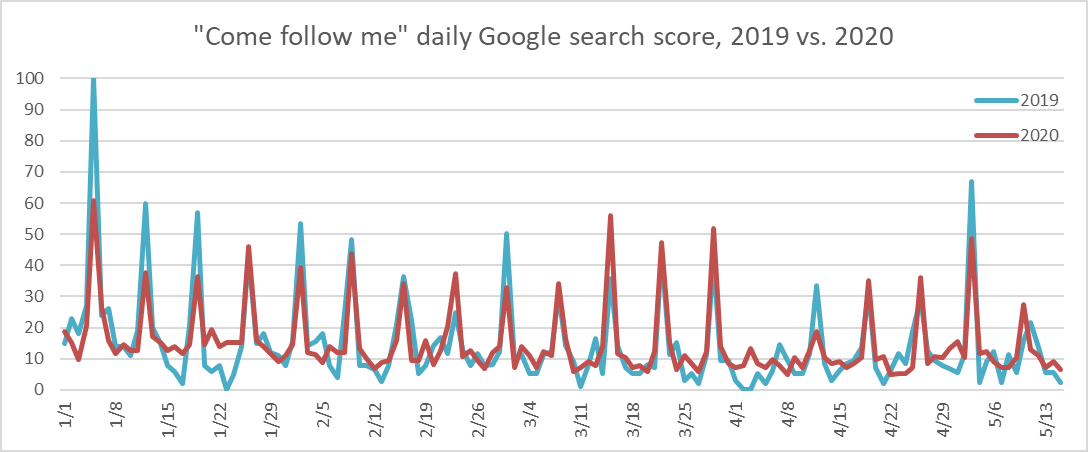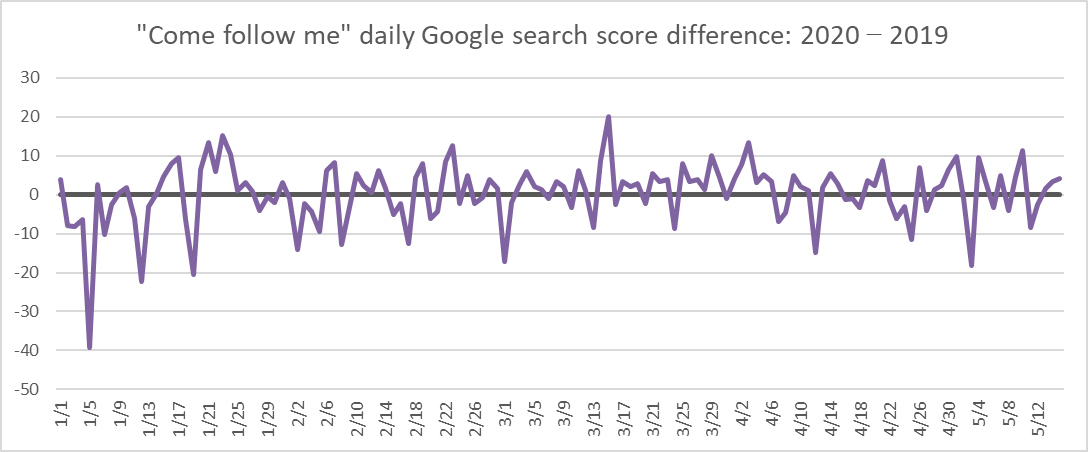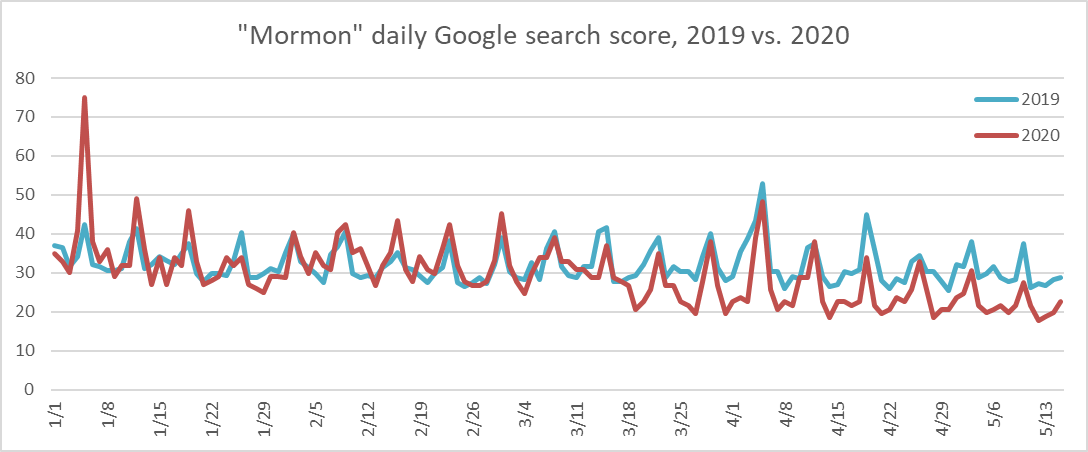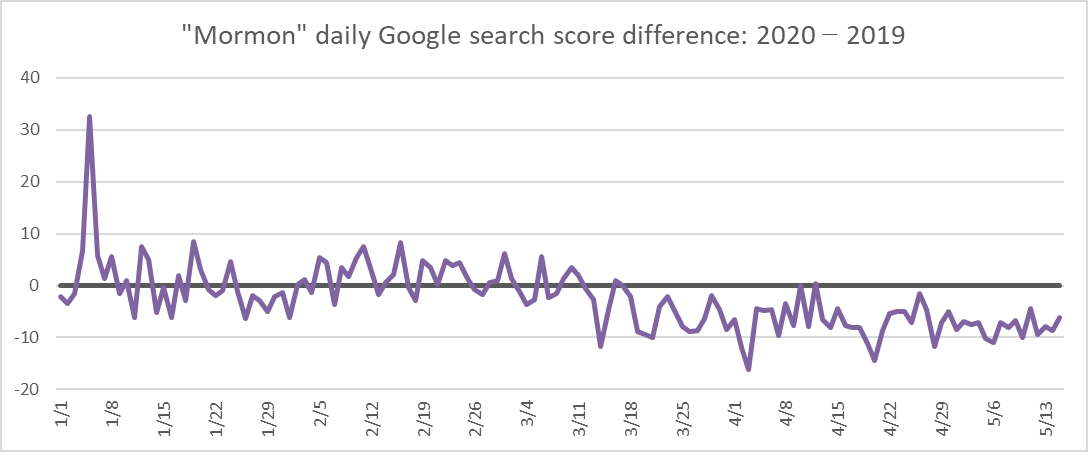I posted a few days ago about change in interest in church (in the LDS Church in particular) during the coronavirus. I used Google Trends data on searches for the Church. Commenters on the post (and on Facebook) made some excellent points about how differences might be attributable to change in interest from Mormons versus from non-Mormons. In this post, I’m going to make a quick attempt to tease that apart. (Commenters also raised other good critiques, such as that a change in Google Trends data might not reflect a difference in organic interest so much as a structural change in how church is happening during the pandemic, that are beyond the scope of what I will look at in this post.)
My approach is simple. Rather than looking at Google Trends data for just the Church itself, I’ll look at data for two different Mormon-related terms, one that’s more often used by Mormons, and one that’s more often used by non-Mormons. For the term more often used by Mormons, I chose “Come Follow Me,” an excellent suggestion Ardis made on my last post. Given that it’s a pretty well-known statement Jesus made in the New Testament, I wouldn’t have guessed how much its usage would be dominated by Mormons, but it clearly is. Looking at the Google Trends data, here are reasons I think it’s mostly being searched by Mormons:
- Search volume is the highest for the US, and within the US, for Utah, followed by Idaho.
- There are weekly Sunday peaks that disappear on Conference weekend.
- The top five associated search terms Google Trends suggests are all Mormon related.
For the term more often used by non-Mormons, I’m using “Mormon,” which is ideal because President Nelson’s campaign to get us to stop saying it is clearly having an effect on people in the Church, but, not surprisingly, hasn’t been so quickly heeded by people outside the Church. As with “Come Follow Me,” the data looks consistent with the expectation of who’s using it, as the peaks are for Mormon-related news stories rather than for General Conference, when searches for the Church peak.
This graph shows daily results for “Come Follow Me” since the beginning of 2019.

As you’d expect, there is a clear weekly trend. The peak point was in the first week when the program was launched. I haven’t called them out in the graph, but you can see clear flat points at General Conference and at Christmas, when the whole Church skipped second hour together. Interestingly, although the peak at the beginning of 2020 was much more modest than the peak at the beginning of 2019, the general level appears to have increased, although it has drifted back down a little since perhaps February. (My first thought was that this jump was an artifact of the way I was stitching together the different daily series. It turns out, though, that I was able to get this long a daily series from just two queries, and the point where they meet is August/September of 2019, so that can’t be the cause.)
This next graph lines up January through May of 2020 with January through May of 2019. As in my last post, I’ve matched dates up by day of the week rather than by day of the month so that the weekly peaks will line up.

There’s the higher initial peak for 2019 like we saw in the previous graph, and the flattening in the first week of April for General Conference. Also, as you might recall from my last post, Easter was two weeks after Conference last year, but only one week after Conference this year, so those Sunday peaks aren’t really comparable. What’s really interesting here, though, is that 2020 search scores don’t really look like they’re down overall compared to 2019. In the weeks between the suspension of church meetings and General Conference in particular, the 2020 scores are clearly higher.
This next graph makes the difference clearer by just subtracting each 2019 score from the corresponding 2020 score. In the previous post, I calculated percentage differences, but I chose to just do subtractions here because some of the smallest 2019 scores are really small, and some of the resulting percentage differences are really large, but not that interesting (e.g., 2 to 6 is a 200% increase).

What’s interesting here, I think, is that after the first few weeks of the year, there really isn’t a consistent pattern. There’s a spike around the time church meetings were suspended, and then pretty much just noise since. This suggests that church interest among Mormons is similar to what it was last year at this time. Or at least it’s consistent with that hypothesis.
This next graph shows daily results for “Mormon” since the beginning of 2019.

Like I was saying before, the big spikes here are for news stories, like the Mormon murders in Mexico in November and the $100 billion investment fund revelation in December. There are smaller spikes for Conference, as well as a big spike at the beginning of this year that I’m not sure what to attribute to. There’s also a weekly trend here, but it’s much less prominent than it is for “Come Follow Me.” This looks like good evidence that non-Mormon usage of “Mormon” is higher than their usage of “Come Follow Me” (even if Mormons were the majority of users of both).
Here’s a comparison of 2019 with 2020 for “Mormon.”

The pattern seems quite clear here: Up to the suspension of church meetings in mid-March, the series for the two years are comparable, but after that, 2020 consistently falls below 2019. I’m not sure what precisely to attribute it to, but it does seem like non-Mormons are searching less for Mormon information. Perhaps it’s because missionaries are largely not out proselytizing. Perhaps it’s because the coronavirus is dominating the news, and stories about churches have been moved to the back burner. Or perhaps it’s a combination of both, or something else entirely. I’m really not sure.
Finally, this graph shows the difference between 2020 and 2019 score, again calculated using subtraction rather than percentage difference.

This makes the pattern from the previous graph even clearer. Since mid-March, there are a few days where the search score for 2020 is comparable to the search score for 2019, but there are none where 2020 is much higher, and for the majority, 2020 is clearly lower.
Taken together, results for these two search terms suggest that the decline in search interest for the LDS Church that I showed in my last post is a function of a decline in interest from non-Mormons rather than from Mormons. Thanks again to the commenters who pointed me to this interesting follow-up!
Very interesting! Often people become more interested in religion in times of stress, mourning, and general upheaval, so the drop of interest suggested by your first graph didn’t totally make sense to me.
On the other hand, using ‘come follow me’ as a search term probably only reflects the most engaged, most practicing members. I think there’s a genre of members who participate in various ways that don’t include keeping up with the come follow me assignments, who could be responding to the suspension of meetings differently. I predict that plenty of people will be excited to meet again for community, but will have reduced enthusiasm for extra administrative meetings.
Perhaps folks are getting accustomed to going straight to their Gospel Library app, and searching within it, rather than through Google? That has been the case with me, anyway.